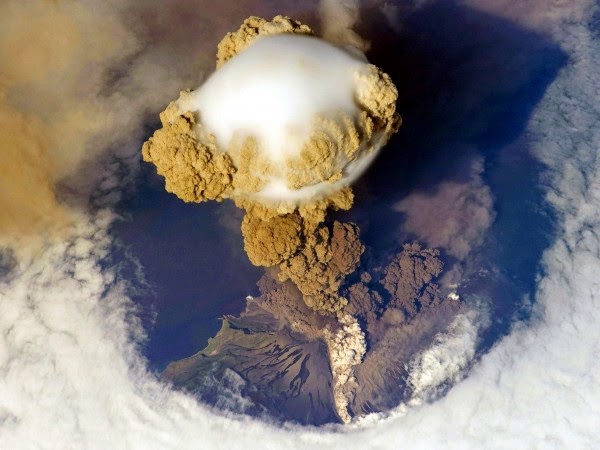
Minor volcanic eruptions substantially slowed Earth’s warming between 2000 and 2013, a new study suggests. The small particles, or aerosols, were spewed high into the atmosphere and scattered sunlight back into space, preventing the global average temperature from rising from 0.05°C to 0.12°C. That cooling effect represents between 25% and 50% of the expected temperature rise during that period because of rising atmospheric concentrations of greenhouse gases, the scientists say, so the finding helps explain the so-called hiatus in global warming over the last 15 years.
“This is an important paper,” says Brian Toon, an atmospheric scientist at the University of Colorado, Boulder. The team’s results “help us understand why Earth didn’t warm as much as expected by climate models in the past decade or so.”
Scientists have long known of the cooling effect of major volcanic eruptions, which spew large amounts of light-scattering aerosols into the stratosphere. The Philippines’ Mount Pinatubo, for example, cooled Earth by a few tenths of a degree Celsius for months after it blew its top in June 1991. But the chilling effect of minor eruptions has been hotly debated, says David Ridley, an atmospheric scientist at the Massachusetts Institute of Technology in Cambridge. That’s because scientists have presumed that most of the aerosols from minor eruptions do not rise beyond the troposphere, the layer of Earth’s atmosphere where weather occurs and where natural processes quickly clear particles from the atmosphere.
As a result, scientists typically ignore satellite data for altitudes lower than 15 kilometers, Ridley says. That’s because the individual droplets or ice particles in clouds (which are, after all, aerosols themselves) in those layers of the atmosphere can confuse the tally, he notes. In the tropics, the boundary between the stratosphere and the troposphere is about 15 kilometers. But in temperate and polar regions, the boundary can be as low as 10 kilometers, Ridley says. That leaves a gap as much as 5 km thick in the lower stratosphere where climate-cooling aerosols can persist, yet not show up, in satellite data.
So, Ridley and his colleagues scoured data from other sources. Some came from ground-based lasers that probed the atmosphere from four sites in the Northern Hemisphere. By measuring the amount of laser light reflected back to Earth, the researchers could estimate the concentrations of aerosols at various altitudes. Data gathered by high-flying balloons and satellites helped provide crosschecks on the laser measurements. Also, a worldwide network of sensors measured the total amount of sunlight reaching the ground, which gave the scientists a sense of how much radiation was being scattered back into space by atmospheric aerosols at all levels.
The team’s analysis reveals that the lower stratosphere indeed contains many untallied aerosols from minor eruptions. Data gathered at a site near Tsukuba, Japan, show that about a third of stratospheric aerosols—much of them from small volcanoes—sit below 15 kilometers. A site near Tomsk, Russia, found that, on average, about half of the stratospheric aerosols resided below 15 kilometers, the researchers will report in a forthcoming issue of Geophysical Research Letters. In these lower layers of the stratosphere, aerosol concentrations rose after known volcanic eruptions and then dropped off, Ridley says.
“What they’ve found makes sense, and it’s important to quantify,” says Alan Robock, a climate scientist at Rutgers University in New Brunswick, New Jersey. The better scientists can pin down natural influences on climate, he says, the better they can understand the impact of human activities.
Yet the cooling effect of these minor eruptions does not completely account for the global warming hiatus in which the rise in Earth’s average temperature has slowed since the late 1990s, Toon says. Scientists increasingly believe that most of the rest of the missing heat has gone into deep ocean waters. Another source of cooling is suspected to be aerosols from industry in East Asia.
In any case, Robock suggests, scientists should develop new sets of sensors or analytical techniques to measure stratospheric aerosols. Whereas some of those instruments could be space-based, others could be borne by high-flying balloons. The latter type of sensors, Robock notes, could directly measure the size distribution of aerosols, which could help researchers better model their effects on climate.
Note : The above story is based on materials provided by American Association for the Advancement of Science. The original article was written by Sid Perkins.










